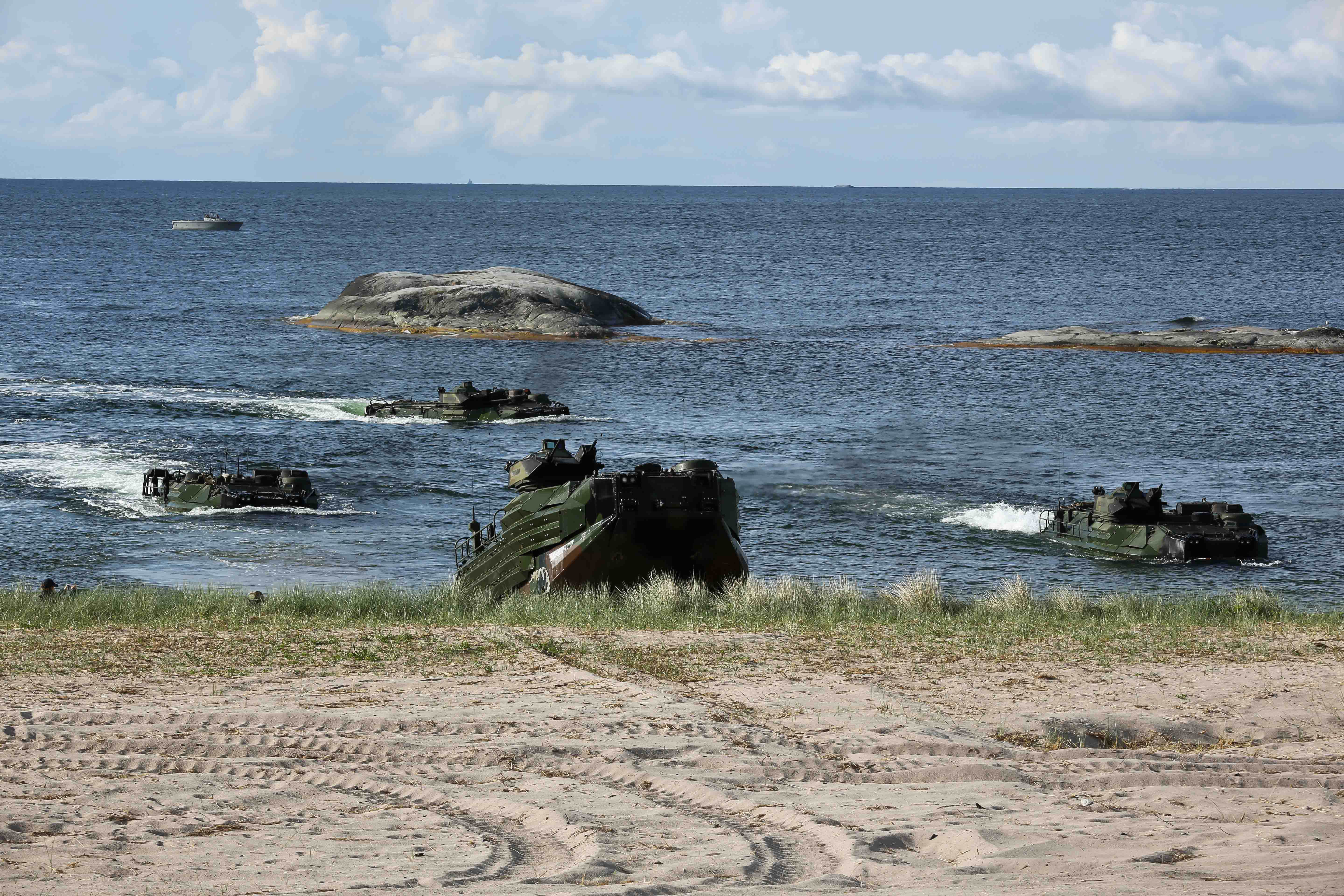
THE PENTAGON — Fifty ships set sail in the Baltic Sea this week for the annual NATO exercise Baltic Operations (BALTOPS), with this year’s event including a larger aviation component and a larger adversary “red force” in the hopes of creating a realistic scenario for high-end warfare in Europe, the Navy’s 6th Fleet commander told reporters today.
Vice Adm. Christopher Grady, who also serves as commander of the Naval Striking and Support Forces NATO, which leads the exercise, told reporters today that 50 ships, 55 aircraft and more than 4,000 personnel will spend two weeks conducting air defense operations, mine warfare and mine countermeasures, anti-submarine warfare, and three major amphibious landings. Focusing on the southern portion of the Baltic Sea, compared to last year’s focus on the northern region, the forces will conduct landings at Vilnius, Lithuania; Putlos, Germany; and Ustka, Poland.
“What we want to do is practice and demonstrate the ability to deliver sea control and power projection at and from the sea,” Grady said in a teleconference aboard USS Arlington (LPD-24). With 14 nations participating – 12 NATO allies, plus Finland and Sweden – “we’ve maintained a consistent level of participation over the last couple of years, and it’s still a very large exercise and a lot of moving parts, a lot of participants that will provide that realistic and challenging training we’re looking for.”
Striving for a realistic warfighting experience drove many decisions about BALTOPS 2017, Grady said. The “free play” portion of the event is longer and includes for red force assets to create a greater challenge. A NATO innovation initiative is bringing in gear such as a Milan anti-tank weapon system that has never been used in BALTOPS before, so countries can participate with the gear they’d actually battle with. And the event focuses on command and control and integration of forces more than previous iterations have, to ensure forces could actually operate together in a fight.
For Baltic nations, that fight would most likely be against Russia. Russia has participated in BALTOPS in the past, with its last appearance being in 2012, but since 2015 it has not been invited to join the international exercise due to annexing Crimea and increasing aggression against the U.S. and Western countries. Grady downplayed Russian activities as a reason for high participation in this year’s exercise.
He did note that three Russian ships – two frigates and an auxiliary ship – were operating in the international waters off Poland when participating ships set sail on June 4, but he said that wasn’t unexpected and their behavior has been “professional and routine.” In comparison, in 2015 – the first BALTOPS exercise post-Crimea – Russian jets flew over the NATO formation and Russian corvettes came up alongside it to “show interest.”
If 2015 was the year the exercise jumped in size to the 50-ship mark, and 2016 was the year the complexity of amphibious landings was pushed to a new level, 2017 is the year of aviation integration.
“The emphasis on air integration is really important to us. We know that we are never going to fight alone – it’s always going to be joint, it’s always going to be combined. Which is why on the combined side it’s a NATO exercise, and on the joint side we want to fight in all domains and practice that and practice that integration. That means air, sea and land,” Grady said.
“One of my strongest initiatives was to increase the level of air integration in the exercise, and to do that we needed the participation of the [Combined Air Operations Center] in Uedem, Germany. And I worked very carefully and closely with [Belgian Air Force Maj. Gen. Thierry Dupont] there, and his entire staff, very pleased that his team working with mine has built a very robust air picture that will help us improve that integration, that complexity and that challenge across all domains, which as I say, we have to train like we’re going to fight.”
The air integration piece is important because it affects all warfare areas, Grady said – from fighter jets conducting air defense, to P-8A Poseidons conducting maritime domain awareness and anti-submarine warfare, to helicopters conducting surface warfare to U.S. Air Force bombers delivering mines.
On the shipboard side, Grady said he was comfortable with the level of ship-to-ship integration, which comes as a result of this being the 45th iteration of BALTOPS and from other international naval exercises throughout the year.
“We’re ahead of the curve on that kind of integration. I was very pleased with the first day and night and then again today underway with our ability to communicate with each other as a force. I consider that a good success,” he said.
“By and large we have been able to build an architecture of communication that allows us to network ourselves with installed equipment (rather than tacked-on antennas for the duration of the exercise), and I think that speaks to the fact that we have done this over 45 years and that we have learned a lot about integration and interoperability and what we as a NATO force need in terms of equipment and building appropriate architectures to work together.”
During the teleconference, Grady spoke of the importance of these international exercises, saying that the participating nations are “experts in specific warfare areas.”
Saying that mine countermeasures is a personal priority – Grady previously commanded two Avenger-class mine countermeasures ships – he said “one of the things that’s great about working with our NATO allies is that each of the partners brings a specific skill set to the table. Our maritime allies, NATO allies and partner allies up here in the Baltics, are superb at mine countermeasures, so we will work the mine countermeasures piece quite extensively. And there are a lot of mine countermeasures ships participating. We will learn a lot from our NATO partners in the mine countermeasures warfare area.”





